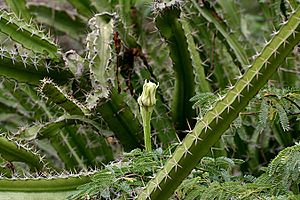Night-blooming cereus facts for kids
Quick facts for kids Night-blooming cereus |
|
|---|---|
 |
|
| Conservation status | |
| Scientific classification | |
| Synonyms | |
|
Acanthocereus pentagonus (L.) Britton & Rose |
The Acanthocereus tetragonus is a type of cactus that grows naturally in many warm places. You can find it in Florida and the Lower Rio Grande Valley of Texas in the United States. It also grows in Mexico, Central America, the Caribbean, and northern South America. Sometimes, it grows where it is not native, like in New Caledonia, where it can become an invasive plant.
People call this cactus by many names. Some common names are night-blooming cereus, barbed-wire cactus, sword-pear, and triangle cactus. In Spanish, it is called Órgano-alado de pitaya. The famous scientist Carl Linnaeus first described this plant in 1753. Later, in 1938, Pieter Wagenaar Hummelinck moved it to the Acanthocereus group of cacti.
Contents
What Does Acanthocereus tetragonus Look Like?
This cactus is quite tall, often growing up to 7 meters (about 23 feet) high. Its stems are dark green and have three to five sides, like a triangle or a pentagon. Each stem can be about 6 to 8 centimeters (2.4 to 3.1 inches) thick.
Small, grey spots called Areoles are found on the stems, about 2 to 3 centimeters (0.8 to 1.2 inches) apart. From these spots grow the cactus's spines. The spines in the center of the areole are usually one or two, and they can be up to 4 centimeters (1.6 inches) long. Around these, there are six to eight shorter spines, about 2.5 centimeters (1 inch) long.
Flowers and Fruit
The flowers of the Acanthocereus tetragonus are very impressive. They are large, about 14 to 20 centimeters (5.5 to 7.9 inches) across. The flower tube, which connects the petals to the stem, is 8 to 15 centimeters (3.1 to 5.9 inches) long. The outer petals are greenish-white, while the inner petals are pure white. The central part of the flower, called the pistil, is creamy white.
These beautiful flowers open only at night, from midnight until the sun rises. They attract special insects like hummingbird moths, which help pollinate them. After the flowers bloom, shiny red fruits grow. These fruits are about 5 centimeters (2 inches) long.
This cactus often forms thick, spiny groups in coastal areas. These groups can be very dense and hard to walk through. The plant blooms a few times each year, with each blooming period lasting several weeks.
How Do People Use This Cactus?
The Acanthocereus tetragonus has several uses.
- Food: Young stems of this cactus can be eaten. You can cook them or eat them raw, like a vegetable. The red fruits are also edible and taste sweet.
- Gardens: Sometimes, people grow this cactus as an ornamental plant because of its interesting look and pretty flowers.
- Fences: It can also be planted to create a living fence, thanks to its tall, spiny stems that make it hard for things to pass through.
Fairy Castle Cactus
There is a special type of this cactus called the Fairy Castle Cactus. It is a miniature version that has many curved branches. These branches look like the turrets of a castle, which is how it got its name!
Images for kids
See also
 In Spanish: Acanthocereus tetragonus para niños
In Spanish: Acanthocereus tetragonus para niños




